Car Design and The Impact of The EV Market (PDF)

The landscape of car design has long been shaped by the presence of the combustion engine, influencing the look and feel of cars throughout the last century. However, as we embrace electric vehicle (EV) technology, with its innovative “skateboard design” chassis, we are on the cusp of witnessing a profound transformation in the aesthetics and functionality of automobiles. Designers are eagerly anticipating this change, though they acknowledge that battery technology must advance further to fully unlock its potential.
Electric vehicles are poised to dominate our roads in the decades ahead. Numerous countries, including the UK, China, Japan, most of Europe, and various US states, have committed to phasing out the sale of new internal combustion engine (ICE) cars by 2035. This transition is already underway, as evidenced by the surging demand for plug-in cars. According to the International Energy Agency, these vehicles are expected to represent 18 percent of the global car market this year, a remarkable leap from just 4 percent in 2020.
EV Market vs Car Design: What Is to Come

For those fortunate enough to be involved in the engineering design of electric vehicles, such as the Riversimple hydrogen fuel cell Rasa, this shift is an exciting departure from the conventional fossil fuel-burning internal combustion engine projects of yesteryears. Traditionally, automakers’ attention has been centered around the design and construction of high-performance sports cars and supercars, where achieving the perfect balance of the car is prevalent. It is intriguing to consider the new design possibilities and challenges that emerge with EVs.
Pure electric vehicles are currently constrained by heavy batteries needed for adequate range, but the future promises improvements in power density, allowing for reduced vehicle weight. Nonetheless, they shine as performance cars, offering instantaneous and robust torque. One could argue that fossil fuel-burning hybrid vehicles, burdened by onboard generators and fuel, are overly complex and likely to have a short-lived tenure.
Take the Tesla Model S, particularly the P90/100D version, as an example. It’s an astonishingly powerful sedan or Qwest shooting brake, yet it tips the scales at 2.6 tons. Imagine harnessing the “skateboard” chassis/floor of the Model S, complete with 4WD motors and batteries, to construct an ultra-lightweight carbon fiber two-seat safety cell that connects the strut tops with the structure and incorporates reduced glass surfaces and doors. Such innovation could potentially result in the Model Y, characterized by exhilarating acceleration.
The rapid expansion of EV charging infrastructure will likely alleviate range anxiety in just a few years, making EV ownership even more appealing. The future indeed looks promising.
EV Design Transformation

The automotive industry is currently undergoing its most profound transformation in a century, marked by electrification, digitization, and autonomy. Each of these transformations demands a fresh perspective and creative solutions. By shedding many of the conventions inherent in internal combustion engine vehicles, electric vehicles offer designers unparalleled freedom and the chance to explore new design languages and proportions.
The mass-market adoption of electric vehicles will usher in a plethora of cars conceived from entirely new perspectives. Some consumers may mistakenly assume that electric cars will resemble today’s transportation options, albeit less thrilling. This couldn’t be further from the truth. We can anticipate a diverse array of vehicles, each distinct from its predecessors in layout and performance.
While autonomous pods may become commonplace, the allure of supercars and the pleasure of driving will endure. Premium electric cars will continue to offer luxury, serenity, and ambiance, as consumers have an innate affinity for exceptional design. The electric vehicle journey, as exemplified by models like the Jaguar I-PACE, is just beginning. With EV numbers projected to skyrocket from 3 million to 125 million worldwide by 2030, the possibilities are boundless. I, for one, am eagerly anticipating what the future holds.
This seismic shift has the potential to revolutionize the appearance of automobiles as automakers race to introduce electrified models. Traditional fossil-fuel-powered cars have been heavily influenced by the presence of various engineering components such as the engine, fuel tank, radiator, transmission, and exhaust pipe. However, as electric vehicles become the standard, we can expect cars to undergo a dramatic transformation, albeit contingent on further advancements in battery technology.
For more car-related topics, check out our blog.





